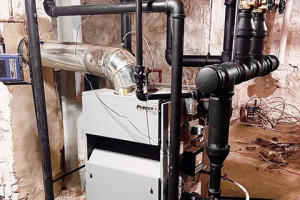
Hello, old friend. I’m writing today to say thanks, and to say farewell. This will be my last column.

Before I retired in 2016, I’d get a lot of calls from lawyers who wanted to hire me to be an expert witness at a trial. They were almost always representing a building owner. I always said “no thank you,” because I like to keep stress out of my life.
That wasn’t the case with one guy I knew back then. He used to testify in court against people who were suing their heating companies. He said it was easy money and his sincerity shone like a halo whenever he spoke from the witness stand about things to do with heating. If you went into court believing you'd done the right thing by the customer, you'd walk out feeling guilty anyway. And it was all because of my guy's ability to make you believe he knew absolutely everything there was to know about heating systems.
At his invitation, and just before he gave up on being an expert witness, he invited me to watch him work. He did okay for the first few minutes, but then the defendant’s lawyer asked him this simple question: “What is heat?”
“Excuse me?” he questioned.
“Heat. What is it?” the lawyer replied.
"What do you mean by that?" my guy said.
"It’s a simple question,” the lawyer said. “Do you know what heat is?”
"Of course I do,” my guy said. “I'm a heating expert."
"So what is heat?" the attorney asked again. “You're a heating expert. It's a simple question. What...is...heat?"
My guy looked at the jury, smirked and turned back to the lawyer. “Heat is the absence of cold," he said and smiled.
"I didn't ask you what heat isn't,” the attorney said, “I asked you what it is. Now, once again. What is heat?"
It hurt to watch that exchange. My guy couldn’t answer. The question wasn’t about pipes, pumps or boilers. It was about physics. It was a question he had never considered. What is heat?
He could have said heat is energy that moves between two things. That would have been sufficient and he would probably still be doing expert witness work. But, he didn’t say that.
Heat can be confusing.
I looked at a problem job a bunch of years ago in an office building. This building had a wide, open-at-both-ends driveway that passed beneath its first floor to a parking lot out in the back. Winter wind howled down that driveway and constantly chilled the concrete that formed the building's first floor.
"The people who work in that first-floor office are freezing," the guy in charge of the building told me. “There’s lots of glass and the tile floor is freezing.”
"I'm not surprised," I said. "What we have here is a great example of radiant cooling."
"I think we need more heat," he said.
"I think you're right," I said.
"It won't be hard to do, though," he said. "We have 1-1/4-inch commercial fintube baseboard running around the perimeter now. There's room in the cabinet to add a second tier of fintube. That will double the heat in there and everything should be fine."
"How do you figure it will double the heat?" I asked.
"What do you mean? There will be twice as much fintube in the room. That's twice as much heat," he said.
"What is heat?" I asked.
"Huh?" he said.
"What is heat?" I repeated.
"What are you talking about?" he asked.
"Is fintube heat? Or does it have the ability to give off heat?” I asked.
"Oh, I see what you're getting at," he said. "Okay, it has the ability to give off heat. And with twice as much ability to give off heat, we'll give off twice as much heat, okay?"
"How do you figure that?" I asked.
"What are you? A wise guy?" he quipped.
"Nope,” I said. “Just curious. Are you going to change the size of the pipes leading to the fintube?"
"No, I can't get to those pipes. They're all behind the walls," he explained.
"Are you going to raise the temperature of the boiler water?" I asked.
"I hadn't planned on it. We're already running it at 200°," he said. “We boosted it up from 180°. That helped a bit, but not enough.”
"If you're delivering the same flow rate at the same temperature to the fintube, how can you double the amount of heat that comes off it by adding fintube? Without increasing the flow rate or the water temperature, you're going to be delivering the same amount of heat as you always have. Twice as much fintube will just mean you'll give it up faster to the air in the room. And keep in mind the second tier of fintube sitting above the lower tier isn’t going to give up that much heat because the air entering from the lower tier will already be heated," I said.
"I didn’t think of that," he said.
"Let’s figure it out,” I said. “You now have a 1-1/4-inch supply line to the existing fintube, right?"
"Yes," he replied.
"Okay, under normal conditions, you can get about 14 gpm through that line,” I said. “Each gpm represents about 10,000 Btu, meaning you can deliver about 140,000 Btu to that zone."
"Okay," he said. "Now let's split the flow rate in two when it gets to the fintube because that's exactly what you'll be doing when you add that second tier of fintube inside the cabinet,” I continued. “That’s also assuming you balance the flow between the two tiers because if you don't, the water will go into whatever place easiest to get into."
"Okay," he said again.
"Now, how much water should flow through each tier of fintube, assuming they're in balance?" I asked. He hesitated and then said, "14 gpm."
"Through each one?" I asked.
"Sure," he answered.
"Think about what you're saying." I said. "You're delivering 14 gpm to the fintube through the 1-1/4" supply main."
"Right," he said.
"So how can it suddenly turn into 28 gpm when it hits the fintube?" I asked.
"Because there's twice as much space in the pipe,” he said.
"But the fintube is getting its supply from, the 1-1/4" pipe,” I said. “The pump is only delivering 14 gpm. When that flow hits the two tiers of fintube, it will split in half. Each tier will get about 7 gpm, assuming everything is in balance. You'll be delivering about 70,000 Btu to each tier, not 280,000 Btu."
"I'm starting to see what you mean," he said.
"If we could figure out a way to suddenly double the quantity of heat you're delivering to the building in the middle of the zone, we'd really be onto something, wouldn't we? We would be magicians,” I said.
"So I guess doubling the amount of fintube won't help us here, will it?" he said.
"Not unless we increase the size of the pipe that has to deliver the goods. And not unless we check to see if the boiler can also deliver the additional goods. And not unless we raise the boiler temperature even higher,” I answered.
He nodded. He wasn’t happy, but he nodded.
So back to the question that stumped the expert witness: What is heat? Heat is energy that moves from here to there. Heat is not the baseboard, nor is it the pipe, valves or fittings. It's not the circulator, and it's not the boiler.
These are just the things that deliver the heat.
So the next time you run into a heating problem, pretend you’re the heat and ask this simple question: "If I were heat, could I make it to where the people are?" And then take a look at the size of the pipes. Look, too, at where the tees are and ask, "If I were heat, which way would I go?" And while you're at it, look at that extremely long loop of baseboard and say, "If I were heat, wouldn't I have gotten off somewhere else up the line? Maybe that's why the fintube way down over here is lukewarm."
If you want to be a heating expert, you first have to understand what heat is.

Hello, old friend. I’m writing today to say thanks, and to say farewell. This will be my last column.

My six-year-old grandboy, Brendan, was in the vestibule of the diner when the bubblegum machine caught his attention. It was one of those spiral models that appeared in t...

Subdural posed a question on The Wall at HeatingHelp.com in the Strictly Steam section, where some of the sharpest knives in the drawer post every day. The question was a...